
The Solar-Terrestrial Centre of Excellence (STCE) is a collaborative network of the Belgian Institute for Space Aeronomy, the Royal Observatory of Belgium and the Royal Meteorological Institute of Belgium.
 |
Published by the STCE - this issue : 27 Sep 2012. The Solar-Terrestrial Centre of Excellence (STCE) is a collaborative network of the Belgian Institute for Space Aeronomy, the Royal Observatory of Belgium and the Royal Meteorological Institute of Belgium. |
| Archive of the newsletters | Subscribe to this newsletter by mail |
PROBA2 is an ESA micro-satellite that was launched on November 2, 2009.
It carries an on-board camera to image the Sun in the Extreme Ultra-Violet (EUV). The images obtained with this SWAP-instrument show the solar corona at 1 million degree, with a cadence of 1 image per 1-2 minutes, and a field of view (FOV) of minimum 1.7 solar diameters. More information on this imager is available at http://proba2.oma.be/about/SWAP
As PROBA2 radioed the first SWAP-images to Earth early January 2010, there are now more than 2.5 years of EUV-images available. This corresponds to the rising phase of the ongoing solar cycle 24.
At the most recent Solar Orbiter workshop (http://www.stce.be/solarorbiter5/), the SWAP-team presented a movie showing the evolution of the solar corona throughout this period (February 2010 till July 2012). This movie is available at http://proba2.oma.be/Presentations/20120910_SolarOrbiter5/mission_stack_movie_slow.mp4
The increase of active regions (bright) is easily noticed. These areas often correspond to sunspot regions. Initially the northern hemisphere dominates the solar activity, but at the end of the period the southern hemisphere catches up.
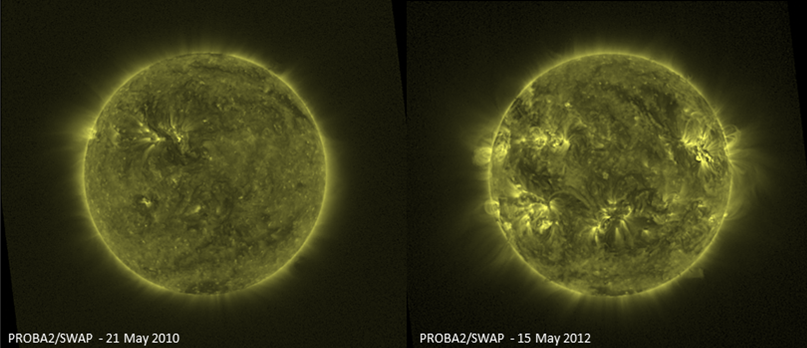
Because the solar rotation axis is not perpendicular to the plane of the Earth around the Sun, we have a better view on the solar north pole during August-October, and on the solar south pole during February-April. This can also be seen in the SWAP-movie, where one has a better view on the polar coronal holes pending the month of observing. These coronal holes have a dark appearance because they are colder and less dense than the surrounding (coronal) areas. The polar coronal holes are explicitly present during solar minimum. As the solar cycle gradually progresses, coronal holes can appear all over the solar surface. The SWAP-image underneath (29 June 2010) shows the northern polar coronal hole with a large extension up to mid-latitudes.
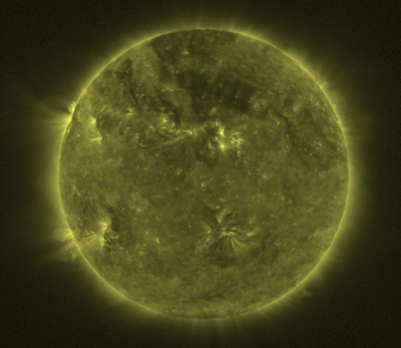
Some of the dark, long-stretched features are not coronal holes, but filaments. These are areas of dense, but cool material in the Sun's lower atmosphere where they separate regions of opposite magnetic polarity. They can become very long, some even longer than a solar radius! The distinction between a stretched coronal hole and a filament can be made using different filters (coronal holes do not show up in lower temperature filters), or when the object reaches the solar limb: If it is a filament, its silhouette can then be seen in EUV as a dark feature towering over the limb against the bright coronal background. Note that in EUV, not all dark, stretched areas delineating regions of opposite magnetic polarity have a chromospheric counterpart. Such areas are sometimes called "pseudo coronal holes". In the figure underneath, borders separating areas of opposite magnetic polarity were indicated by red if they have a visible filament in the chromosphere, or dashed-orange if not (or only partially). The areas in blue indicate coronal holes. Images are from the Kanzelhöhe observatory (http://cesar.kso.ac.at/ ), PROBA2/SWAP and SDO/AIA193.
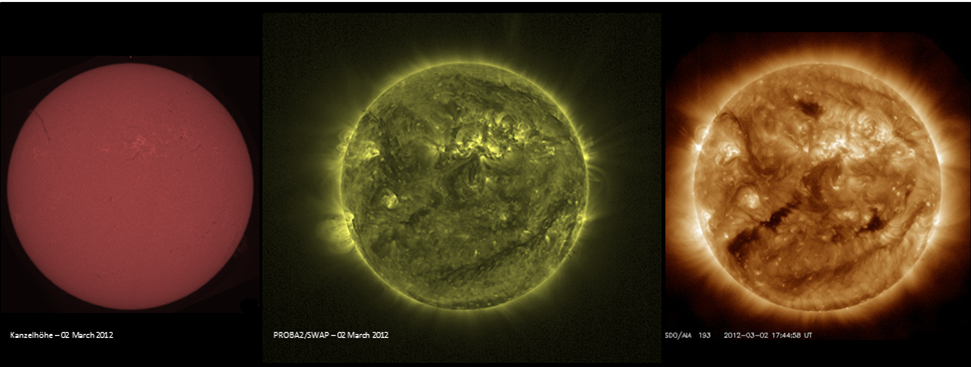
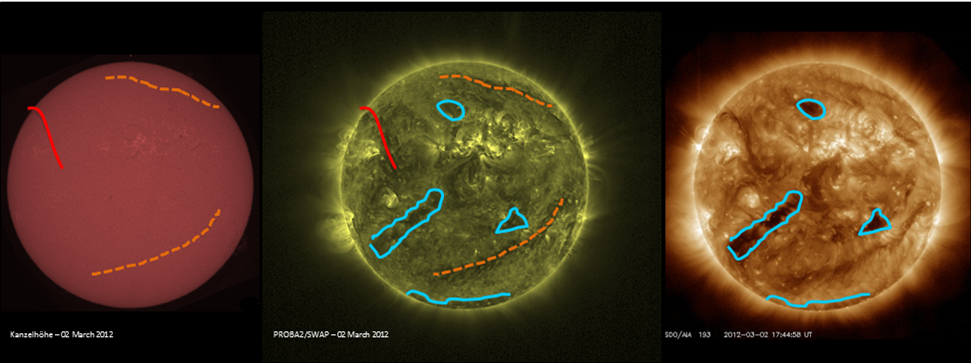
The flaring activity was low during this week with only eight weak C-class flares reported by GOES. The strongest flare of the week was C 2.6 flare, on September 19. The flare originated from the Catania sunspot group 88 (NOAA Active Region 1576) and peaked at 15:12 UT.
Four halo and two partial halo Coronal Mass Ejections (CMEs) were observed this week, all of them backside events and associated with the flares at about at about 60 degrees behind the East limb as seen from the Earth (on September 21). The CMEs were not directed to the Earth due to their source region positions on the far side of the Sun.
On September 19, in close succession, two full halo CMEs were observed. The CMEs were first seen in SOHO's LASCO-C2 field of view at 11:48 and 12:36 UT, respectively.
Two full halo CMEs were observed on September 20. The first CME appeared in the SOHO LASCO-C2 field of view at 05:48 TU, and the second at 15:12 UT. The second CME was associated with a dimming and EIT wave. Images underneath show the view by STEREO-B(ehind) on this strong flare and by SOHO on the subsequent CME.
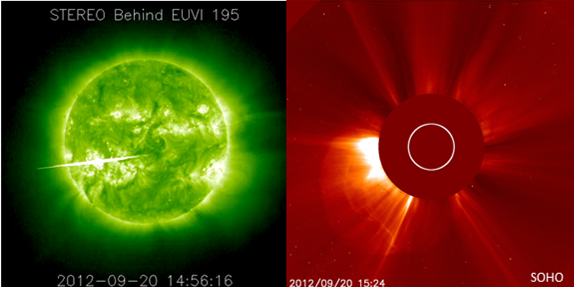
On September 21, a partial halo CME was observed. The CME was first seen in the SOHO coronagraphs (LASCO-C2) at 06:12 UT. The second partial halo CME observed this week was on September 23, at 14:48 UT. The CME was associated with a dimming and EIT wave.
Geomagnetic conditions were quiet to active this week. In the beginning and the end of the week, the Earth was inside a slow solar wind flow, and the geomagnetic conditions were quiet. ACE solar wind data showed the arrival of the solar sector boundary on late September 19, which preceded the arrival of the fast stream due to the small coronal hole, early on September 20. The solar wind speed reached the maximum value of about 550 km/s on the same day.
The influence of the high speed stream was accompanied with the stable value of the interplanetary magnetic field (about 5 nT). The occasional intervals of negative value of the Bz component of the interplanetary magnetic field (up to -10 nT) caused active to minor storm geomagnetic conditions (Dourbes reported K=4, and IZMIRAN reported Kp=5) on late September 19.
Solar Activity
This week, the Sun's activity level was *Low* to *Very low*.
During the week, new active regions appeared on the East limb, increasing the back-ground EUV radiation.
On Sunday 23rd, a big eruption could be seen on the East limb.
Below is a SWAP difference image of that eruption:
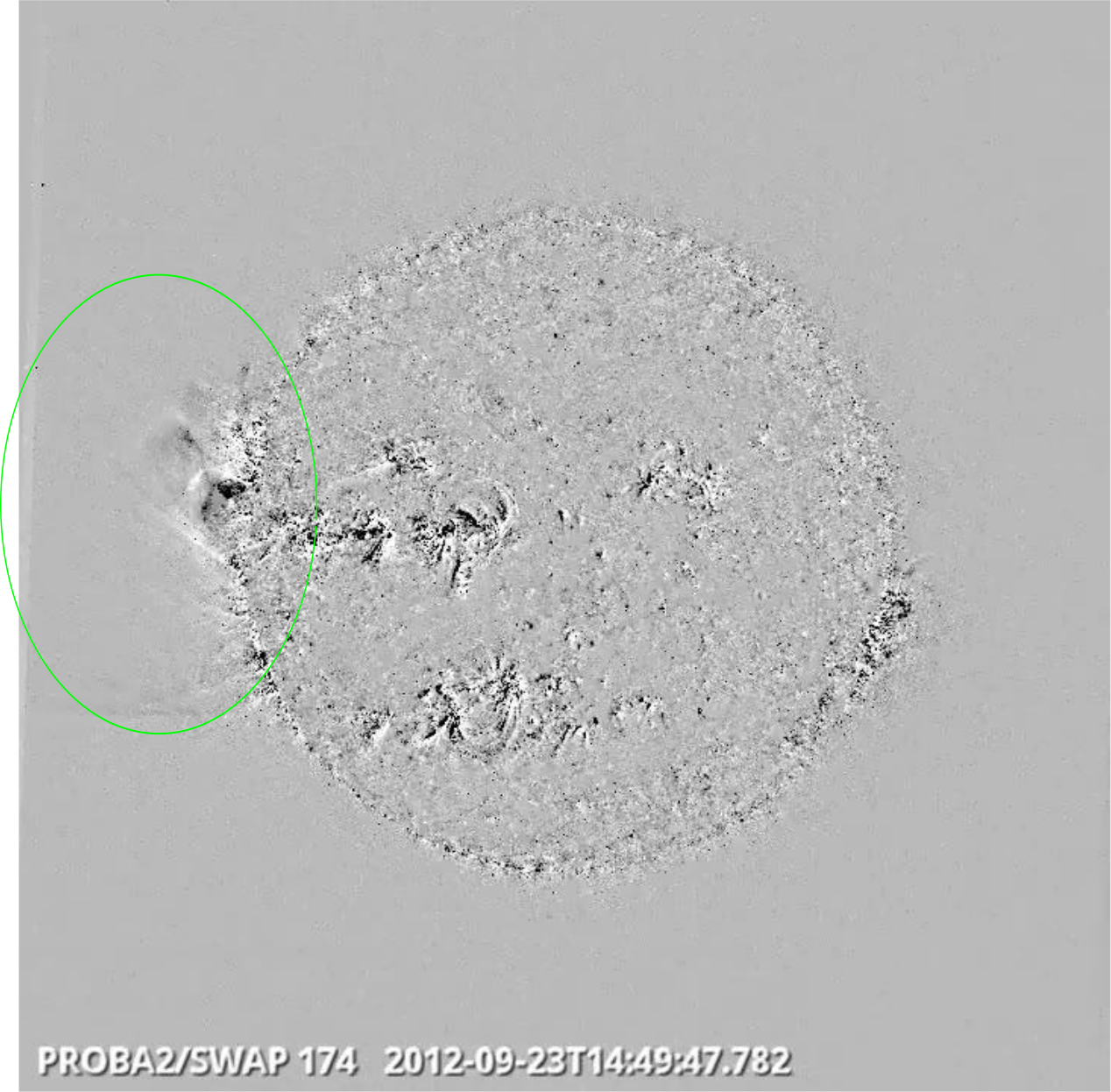
In order to view the activity of this week in more detail, we suggest to go to the following website from which all the daily (normal and difference) movies can be accessed: http://proba2.oma.be/ssa.
This page also lists the recorded flaring events.
The SALE Executive is pleased to announce that a set of high level talks on
various aspects of the energetic particle radiation hazard to aviation crews
and personnel aboard spacecraft in LEO will be presented at a meeting of the
Spacecraft, Aircraft and Launcher Environments group during Space Weather
Week in Brussels, Belgium (8 November, 2012).
Abstracts of these talks are attached and EVERYONE is cordially invited to
attend on this very special occasion.
http://www.spaceweather.eu/en/repository/show?id=252
Invited talk in the session Solar Magnetism and the Solar Cycle.
http://www.spaceweather.eu/en/repository/show?id=253
Presentatie over de 24ste zonnecyclus voor leden van de volkssterrenwacht Urania in het kader van hun wekelijkse voordrachten. Een basiskennis is vereist.
http://www.spaceweather.eu/en/repository/show?id=254
Presentatie over de zon voor leden van de volkssterrenwacht MIRA in het kader van een cursus sterrenkunde. Een basiskennis is vereist.
http://www.spaceweather.eu/en/repository/show?id=255
Talk in the session Solar magnetism and the solar cycle
http://www.spaceweather.eu/en/repository/show?id=256
Talk in the session Solar Magnetism and the Solar Cycle
http://www.spaceweather.eu/en/repository/show?id=257
Talk in the session Solar Magnetism and the Solar Cycle
http://www.spaceweather.eu/en/repository/show?id=258
Talk in the session Solar Magnetism and the Solar Cycle
http://www.spaceweather.eu/en/repository/show?id=259
Talk in the session Solar Magnetism and the Solar Cycle
http://www.spaceweather.eu/en/repository/show?id=260
Talk in the session Processes of slow/steady energy release in the solar atmosphere and heliosphere
http://www.spaceweather.eu/en/repository/show?id=261
Talk in the session Processes of slow/steady energy release in the solar atmosphere and heliosphere
http://www.spaceweather.eu/en/repository/show?id=262
Talk in the session Processes of slow/steady energy release in the solar atmosphere and heliosphere
http://www.spaceweather.eu/en/repository/show?id=263
Talk in the session Processes of slow/steady energy release in the solar atmosphere and heliosphere
http://www.spaceweather.eu/en/repository/show?id=264
Talk in the session Processes of slow/steady energy release in the solar atmosphere and heliosphere
http://www.spaceweather.eu/en/repository/show?id=265
Talk in the session Processes of slow/steady energy release in the solar atmosphere and heliosphere
http://www.spaceweather.eu/en/repository/show?id=266
Invited talk in the session Processes of slow/steady energy release in the solar atmosphere and heliosphere
http://www.spaceweather.eu/en/repository/show?id=267
Invited talk in the session Processes of slow/steady energy release in the solar atmosphere and heliosphere
http://www.spaceweather.eu/en/repository/show?id=268
Talk in the session Processes of slow/steady energy release in the solar atmosphere and heliosphere
http://www.spaceweather.eu/en/repository/show?id=269
Invited talk in the session Eruptive processes in the solar atmosphere and their manifestations in the heliosphere
http://www.spaceweather.eu/en/repository/show?id=270
Talk in the session Eruptive processes in the solar atmosphere and their manifestations in the heliosphere
http://www.spaceweather.eu/en/repository/show?id=271
Talk in the session Eruptive processes in the solar atmosphere and their manifestations in the heliosphere
http://www.spaceweather.eu/en/repository/show?id=272
Invited talk in the session Eruptive processes in the solar atmosphere and their manifestations in the heliosphere
http://www.spaceweather.eu/en/repository/show?id=273
Talk in the session Eruptive processes in the solar atmosphere and their manifestations in the heliosphere
http://www.spaceweather.eu/en/repository/show?id=274
Talk in the session Eruptive processes in the solar atmosphere and their manifestations in the heliosphere
http://www.spaceweather.eu/en/repository/show?id=275
Talk in the session Eruptive processes in the solar atmosphere and their manifestations in the heliosphere
http://www.spaceweather.eu/en/repository/show?id=276
Talk in the session Eruptive processes in the solar atmosphere and their manifestations in the heliosphere
http://www.spaceweather.eu/en/repository/show?id=277
Invited talk in the session Eruptive processes in the solar atmosphere and their manifestations in the heliosphere
http://www.spaceweather.eu/en/repository/show?id=278
Talk in the session Eruptive processes in the solar atmosphere and their manifestations in the heliosphere
http://www.spaceweather.eu/en/repository/show?id=279
Talk in the session Eruptive processes in the solar atmosphere and their manifestations in the heliosphere
http://www.spaceweather.eu/en/repository/show?id=280
Talk in the session Eruptive processes in the solar atmosphere and their manifestations in the heliosphere
http://www.spaceweather.eu/en/repository/show?id=281
Talk in the session Eruptive processes in the solar atmosphere and their manifestations in the heliosphere
http://www.spaceweather.eu/en/repository/show?id=282
Talk in the session Data assimilation, visualization and analysis
http://www.spaceweather.eu/en/repository/show?id=283
Invited talk in session Data assimilation, visualization and analysis
http://www.spaceweather.eu/en/repository/show?id=285
Talk in session Data assimilation, visualization and analysis
http://www.spaceweather.eu/en/repository/show?id=286
Talk in session Data assimilation, visualization and analysis
http://www.spaceweather.eu/en/repository/show?id=287
Talk in session Data assimilation, visualization and analysis
http://www.spaceweather.eu/en/repository/show?id=288
Invited talk in session Data assimilation, visualization and analysis
http://www.spaceweather.eu/en/repository/show?id=289
Invited talk given in the Session Solar Magnetism and the solar cycle
http://www.spaceweather.eu/en/repository/show?id=290
Talk in the session Eruptive processes in the solar atmosphere and their manifestations in the heliosphere.
http://www.spaceweather.eu/en/repository/show?id=291
Talk in session Data assimilation, visualization and analysis
http://www.spaceweather.eu/en/repository/show?id=292
Start : 2012-10-01 - End : 2012-10-05
At the forthcoming 63rd International Astronautical Congress in
Naples a special session on the theme 'Effects of Space Weather
on GEO
Satellites' will be held as part of
the 25th Symposium on Space Policy, Regulations and Economics.
This session will discuss case histories and mechanisms of
effects of space weather
on GEO
satellites, models for prediction,
and mitigation approaches. We would like to invite you to consider
submitting abstracts for this session.
The call for papers can be found at
The
deadline for abstract submission is 29 February 2012.
http://www.iafastro.org/docs/2012/iac/IAC2012_CallForPapers.
Website: http://www.iac2012.org/
Start : 2012-10-08 - End : 2012-10-12
Initiated in 1990, the United Nations Basic Space Science
Initiative (UNBSSI) has contributed to the international and
regional development of astronomy and space science through annual
workshops organized under the umbrella of the United Nations,
focusing specifically on the International Heliophysical Year 2007
(IHY, 2005-2009) and the International Space Weather
Initiative (ISWI, 2010-2012).
UNBSSI has led to the establishment of planetariums, astronomical
telescope facilities, and IHY/ISWI instrument arrays worldwide,
particularly in developing nations. ISWI is envisioned to continue
the tradition of IHY in the worldwide deployment of space weather
monitoring instrument arrays. To
date, ISWI contributes to the observation of space weather
through 18 instrument arrays with
close to 1000 operating instruments in more than 100 nations
supported by designated national ISWI coordinators.
The first workshop on ISWI was held in Helwan, Egypt and hosted
by the Helwan University, Egypt, in 2010, particularly for the
benefit of nations in Western Asia. In 2011 the United
Nations/Nigeria Workshop on ISWI was hosted by the Centre for Basic
Space Science of the University of Nigeria at Nsukka, Nigeria,
particularly for the benefit of nations in Africa. The third ISWI
workshop will be hosted by Ecuador in 2012 for the region of Latin
America and the Caribbean.
Website:
http://iswiecuador.epn.edu.ec/
Start : 2012-10-22 - End : 2012-10-24
2012 - 2013 is expected to be years with high solar activity.
This can trigger larger solar storms which can generate geomagnetic
induced currents (GIC
) on the earth. GIC
can affect the normal operation of
specific industrial operations and critical infrastructure (e.g
power grids, telecom, navigation systems, etc).
During space weather
events, like solar storms, electric
currents in the magnetosphere
and ionosphere
experience large variations, which
manifest also in the earth's magnetic field. These variations
induce currents (GIC
) in conductors operated on the
surface of the earth. Electric transmission grids and buried
pipelines are common examples of such conductor systems. GIC
can cause problems, such as
increased corrosion of pipeline steel and may disturb and possible
damaged high-voltage power transformers and it can also have
damaging effects on communication systems, navigation systems and
oil and gas operations.
Vulnerable industries are the oil and gas industry, railways,
telecommunication industry, navigation industry and not at least
the society, which is very vulnerable concerning short or long term
interruption of critical infrastructure.
The conference will focus on increasing the general knowledge of
solar storms, space weather
and GIC
and the possible consequences for
different industries and critical infrastructure, and look into
reasonable means of protection, and consider possible early warning
solutions.
Website:
http://www.tiems.info/about-tiems/oslo-conference-2012.html
Start : 2012-11-05 - End : 2012-11-09
We are pleased to announce that the Ninth European Space Weather
Week will take place at the
Académie Royale de Belgique, Brussels, Belgium between 5
and 9 November 2012.
This meeting is being jointly organised by the Solar-Terrestrial
Centre of Excellence (STCE), ESA
, the SWWT and the COST ES0803
communities. The local organisation is done by the STCE. This event
will continue to build on the advances made during the first eight
European Space Weather
Weeks held between 2004 and
2011.
Website:
http://www.sidc.be/esww9/
Start : 2012-11-06 - End : 2012-11-09
The International Symposium on Solar-Terrestrial Physics will be
held during November 6 - 9, 2012 at the Indian Institute of
Science, Education and Research, Pune, India. This meeting under
the aegis of the SCOSTEP is expected to draw leading scientists
from around the world in the increasingly important,
interdisciplinary fields of Solar activity and its impact on
geospace and life on the Earth. With major observational solar
facilities being planned in India, this meeting is especially
pertinent in the Indian context.
The meeting is expected to involve professional scientists as
well as graduate students, and will have a mixture of invited and
contributed talks and posters. There will also be a one-day
tutorial for the benefit of young people beginning work in the
field of solar-terrestrial physics.
Website:
http://www.iiserpune.ac.in/~isstp2012/
Start : 2012-11-12 - End : 2012-11-16
As we emerge from one of the deepest and longest solar minima on
record, with a new and powerful eye on the Sun -SDO- we invite all
those with an interest is solar activity to gather in beautiful
Palm Cove, Australia to review and assess our current knowledge and
understanding of our magnetic star
, and to experience the awe and
wonder of a total solar eclipse on November 14, 2012.
Website:
http://moca.monash.edu/eclipse/
Start : 2012-11-13 - End : 2012-11-13
For more information:
http://eclipse.gsfc.nasa.gov/OH/OH2012.html#SE2012Nov13T
Start : 2012-11-15 - End : 2012-11-16
The European Commission will organise the 'Let's embrace
space - FP7 Space Conference 2012', in cooperation with the Cypriot
EU Presidency, on 15 and 16 November 2012 in Larnaca, Cyprus.
This scientific conference will present the current status and
results of the 3rd call of FP7 space research, and also discuss
future options for European research in the space field. In doing
so, the conference will aim at demonstrating the evolution and use
of space tools for a sustainable economic and environmental
development in a European and global context.
Website:
http://www.fp7-space.eu/news-119.phtm
Start : 2012-11-20 - End : 2012-11-23
Nobeyama Radioheliograph (NoRH) has been observing the Sun since
1992. This year is the 20th year of science operation. Instruments
are still in good shape and producing images of the Sun every day
with the same quality as the beginning. Due to the nature of the
instrument and long and uniform observations, data can be used for
wide variety of solar physics and also for solar terrestrial
physics. To mark the 20 years of operation, we will organize a
symposium to summarize what has been done with NoRH and to discuss
what we should do in the future. Papers to be presented in the
meeting will be mainly concerned with the results from NoRH and
future plans.
Website:
http://st4a.stelab.nagoya-u.ac.jp/SPRO2012/
Start : 2012-11-30 - End : 2012-12-05
The overarching objective of the conference is to examine the
connections amongst the phenomena that lead to solar eruptive
events. The current state of themes includes:
* Measuring the Coronal Magnetic Field;
* Connections to, and Reactions of, the Large-Scale Corona;
* Large-scale Magnetic Connectivity of Active Regions;
* Transfer of Energy to, and Storage of Energy in, the
Corona;
* The High-Energy Particle - Flare - CME
connection.
Working groups will address topics such as:
* Energy Transfer throughout a Solar Eruptive Event;
* Global Energetics of an Ensemble of Events;
* Coronal Influences to the Lower Atmosphere;
* CME
Initiation and Type II Bursts;
* The Release of Energetic Particles in the Low Corona;
* Flows vs. Waves;
* Microflares/Nanoflares.
Website:
http://hessi.ssl.berkeley.edu/petaluma/index.shtml
Start : 2013-01-13 - End : 2013-01-19
Information coming soon!
Website:
http://sd-www.jhuapl.edu/Aurora/ESSE/index.html
Start : 2013-03-03 - End : 2013-03-08
Living With a Star
's Solar Dynamics Observatory
invites you to its 2013 Science Workshop to be held March 3-8, 2013
at the Hyatt Regency Chesapeake Bay in Cambridge, MD
(http://chesapeakebay.hyatt.com/). The workshop is a follow-on to
the 'Many Spectra of Solar Activity' workshop held May 1-5, 2011 in
Squaw Valley, CA.
Scientific sessions will feature a broad spectrum of science
topics fundamental to SDO's science investigations:
Atmospheric Imaging Assembly (AIA), EUV Variability Experiment
(EVE), and Helioseismic and Magnetic Imager (HMI), as well as the
overlap between SDO and other scientific missions and
activities.
Website:
http://lws-sdo-workshops.org/
Start : 2013-03-10 - End : 2013-03-15
Spacecraft observations have established that all magnetized
planets in our solar system interact strongly with the solar wind
and possess well-developed
magnetotails. Magnetotails are the site for many dynamic processes
critical to the circulation of mass, energy and magnetic flux. The
great differences in solar wind
conditions, planetary rotation
rates, ionospheric conductivity, and physical dimensions from
Mercury's small magnetosphere
to the giant magnetospheres of
Jupiter and Saturn provide an outstanding opportunity to extend our
understanding of the influence of these factors. Therefore, this
Chapman conference will provide a forum in which various
communities can come together and discuss recent achievements of
observational, theoretical, and modeling studies with the objective
to develop a deeper understanding of fundamental properties and
processes of planetary magnetotails through a comparative
examination.
Start : 2013-05-10 - End : 2013-05-10
For more information:
http://eclipse.gsfc.nasa.gov/SEplot/SEplot2001/SE2013May10A.GIF
Start : 2013-06-10 - End : 2013-06-16
Topics:
* Prominences : formation, dynamics
* Prominence plasma properties, including prominence
seismology
* Magnetic field : measurements, topology, support
* Large-scale patterns and cyclic evolution
* Prominence destabilization, CMEs, reconstruction in 3D
* ICMEs in the heliosphere, magnetic clouds; their impact on the
Earth environment
* Stellar quiescent and eruptive prominences and stellar CME
* Requirements for future instrumentation and prospects for
future missions
Website:
http://www.iau.org/science/meetings/future/symposia/1065/
Start : 2013-06-24 - End : 2013-06-29
Solar cycle 24 has opened a new era in solar radio physics as we
now have instruments that can probe solar processes from
sub-millimeter to kilometer waves. ALMA and LOFAR are entering
full-operation state and observations of the Sun will be made in
the near future.
At the same time extensive use is being made of radio
spectrometers in space, STEREO
/WAVES and Wind
-WAVES, and existing and upgraded
ground-based instruments like Nobeyama Radioheliograph, Nancay
Radioheliograph, Ratan, SSRT, and many others. These instruments
provide data that enable studies of both energetic particles and
thermal plasma
, enhancing our knowledge of solar
eruptions and acceleration and propagation of particles, all
through the solar chromosphere
and corona and into interplanetary
space.
The CESRA 2013 Workshop will highlight these new observational
capabilities and discuss the theoretical issues connected to solar
radio emission and interplanetary radio physics.
Website:
http://wave.asu.cas.cz/cesra2013/
Start : 2013-07-08 - End : 2013-07-11
The 2013 meeting of the AAS/SPD will be July 8-11 (and possibly
July 12), hosted by the Solar Physics Group of Montana State
University, in Bozeman, Montana.
Website:
http://solar.physics.montana.edu/SPD/
Start : 2013-11-03 - End : 2013-11-03
For more information:
http://eclipse.gsfc.nasa.gov/SEplot/SEplot2001/SE2013Nov03H.GIF